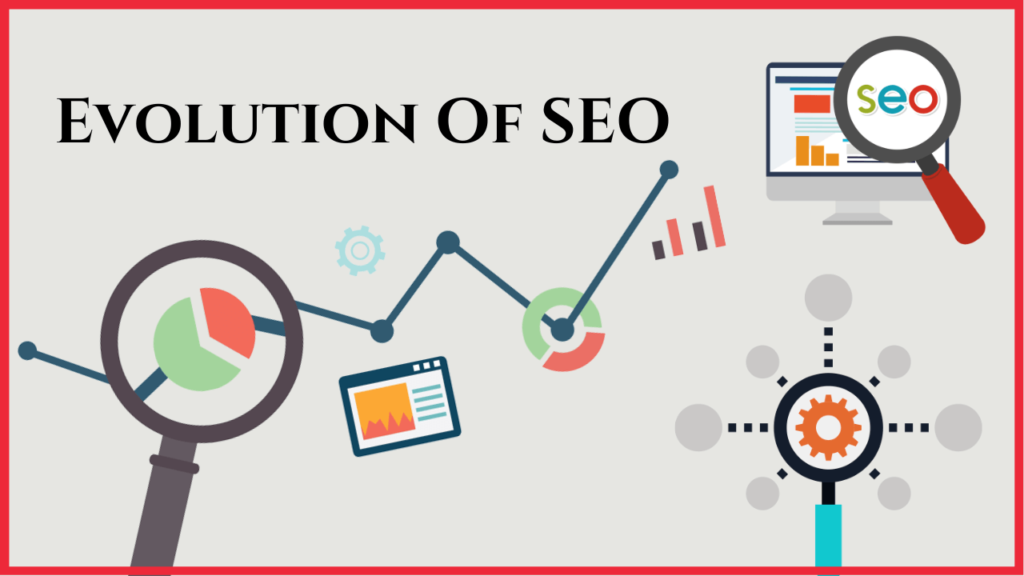SEO has been around long before people started using the internet for their daily needs like socializing, shopping, and more. But, it’s fair to say that search engine optimization was invented keeping the future of the Internet in mind and how it will be used in the future.
Now SEO is used everywhere on the Internet. It aids in increasing the quality and quantity of visitors to your website, allowing you to target individuals who are interested in the items or services you provide.
SEO focuses on increasing a site’s rating in the organic (non-paid) area of a search engine results page. That’s why it is an essential component of a well-rounded inbound marketing approach.
We’ve been utilizing Search Engine Optimization for many years now, but have you ever wondered about the history of SEO? Here’s your chance to learn.
In this article, we have discussed in detail Search Engine Optimization.
History of Search Engine
The search engine is thought to have been born around 1993. After some time one became many as the internet became clogged with web pages. As a result of the great demand for structure and accessibility, the world’s first search engines were built.
Search engines utilize three major principles that it uses to gather data and provide users with the most accurate result.
Crawling
To find new pages and keep track of the latest information search engines utilize web crawlers. These are like small spiders that crawl all over the internet and gather information. Crawlers follow links from already known pages to new ones that have not yet been found. This whole process of discovering new information is known as crawling.
Indexing
After the crawling process, now that the search engine has updated information, it’s time to organize it and it is known as Indexing. Data can be accessed when a search is performed after it is processed and saved in the index. Indexing is important for every website to do so because it helps in being discovered on the internet.
Ranking
This is the final step in the search process. Search engines determine where different pieces of content or URLs should appear in search engine results pages using their algorithm. This whole process is called ranking.
Over the years we have seen multiple Google algorithm updates but the principle of a search engine remains the same.
But, there remains a question of why did Search Engine Optimization start? And how it helps the user or the search engine.
Why did Search Engine Optimization start?
Before talking about why Search Engine Optimization started, first, understand what is SEO? SEO stands for search engine optimization which is a marketing practice that you utilize to help rank your website higher in SERP.

The whole reason behind the existence of SEO is to provide users with relevant information that matches their search results. In the early days of SEO, the regulations were arbitrary. Marketers use hacking techniques such as keyword stuffing and spamming links to rank better in search results.
Looking at this Google recognized this flaw and updated its search algorithm. Based on this algorithm Google will rank content based on white hat SEO practice and provide users with the most suitable results.
Over the years we have seen hundreds of Google algorithm updates that have helped SEO development. These updates have made marketers consider different techniques to rank their business.
The history of SEO shows us that the best approach to prepare for the future of SEO is to utilize ethical optimization strategies and generate content that has genuine value for visitors.
How Google Algorithm updates have shaped SEO over the years?
Sergey Brin and Larry Page founded Google in 1998. Over the years, Google has become more than just a company. It’s our go-to place whenever we need something. As it’s said that “With great power comes great responsibility”, Google had to keep up with the demand while maintaining quality.

That’s why over the years we have seen multiple Google Algorithm updates, some major and some minor. Here are some major Google algorithm updates over the years
- Penguin – This update was done to tackle the webspam. Under this update, any websites were found to be utilizing black hat SEO strategies to influence their results, and these sites were punished.

- Exact Domain Match – This update was aimed to ensure that websites with low domain and page authority don’t rank high just because they have relevant domain names.
- Page layout – The Page Layout algorithm was designed to target websites with a lot of advertisements at the top of the page. According to Google, the algorithm eventually affected 1% of websites.
- Hummingbird – The upgrade underlined Google’s commitment to a better understanding of searcher’s queries. The update leveraged context and query intent to give results that fit the consumers’ needs, and so local searches became more specific.

- Pigeon – This update was to integrate Google’s local algorithms more thoroughly with their traditional web algorithm. As a result of this local businesses now have a greater incentive to compete for local rankings through a strong web presence.

- Panda – This modification was a filter meant to punish thin and bad content. As a result of this upgrade, it is critical to continuously assess and update the website’s content.

- Mobilegeddon – Google adopted this algorithm upgrade to improve its user experience, as mobile devices account for over half of all Google searches. The change had a huge impact on mobile searches and affected all mobile searches in all languages globally.

- RankBrain – Under this update Google introduced AI into their algorithm for the first time. This update helped Google provide search results even when the user might have misspelled the search.

- Possum – The major goal of the Possum upgrade was to weed out spam results and diversify ranked local search results. The change resulted in eliminating businesses that operated from the same location.

- Fred – This update was an attempt to remove low-quality results, and as a result, many affiliate sites were harmed. After this update websites aimed to provide high-quality material that would attract high-quality links.
- Intrusive Interstitials Update – This update was rolled out by Google to make mobile surfing easier. With this update, interstitials appear on pages when users scroll through the content.
- Medic – The medic update mostly impacted health and financial websites. Google stated that there was no “cure” for pages that may have been affected other than to keep creating outstanding content.
- BERT – Known as Bidirectional Encoder Representations from Transformers. This update enhanced the way Google processes search queries. Also due to this update, On-Page components become critical in terms of employing words precisely.
- Payday – The Payday update does not target a website’s content or backlinks. Instead, payday update precisely targets search queries and marketplaces where spam or illicit SEO practices are prevalent.
Apart from these major updates, Google also made some minor updates. These were done to include modifications aimed at improving the quality and relevancy of Google’s search results.
These are different from major updates because they impact only 0.10% to 1% of all searches. On the other hand, major updates affect almost 8% to 10%.
It was these core updates done by Google that have led to drastic modifications in Search Engine Optimization. These ideas lead to optimizing your website and online presence such that it is preferred by Google’s ranking algorithm.
But these major updates by Google have caused many troubles for organizations. Because once a core update is released there is a high chance that all of your time, work, and money invested in optimizing your website might be wiped out.
It’s because a core upgrade might nullify the otherwise beneficial influence of a ranking indication sought by your website. Core changes can even apply penalties that cause your website’s search rankings to plummet.
For example, the Panda update placed an automated and algorithmic penalty on websites with thin content. The Panda update altered the game by punishing pages with minimal content, such as these.
But there is nothing to fear because before dropping any major update Google discloses them. You can visit the official Google page where you can keep track of any such development.
The Evolution Of SEO Trends Over 30 Years
Over the years both the customers and the Internet have evolved for the better, and so has search engine optimization.

SEO has evolved from a basic three-letter word to a complicated framework that builds, and maintains, useful relationships with people after over 30 years. It uses tailored and engaging media to link individuals with the information they want.
To help you understand the evolution of SEO we have prepared an SEO history timeline and have divided the whole journey into three parts.
1. The beginning (1990-2000)
As we have mentioned earlier, it was in 1991 that the world saw its first website. We might have seen the first website then but there were no complicated SEO strategies that we have today.
In fact, in the early days ranking websites was not difficult as it was less crowded. Still, many people use black hat SEO techniques and strategies to rank their websites. Also, their technique went unnoticed because it took months for search engines to deploy algorithm improvements.
But over time Google took a significant move toward SEO uniformity. They introduced laws and regulations that would transform the Internet world forever.
2. Early days (2000-2005)
During this period Google realized the importance of implementing strict rules and regulations to stop black hat SEO practices. When Google implemented these rules, it drastically altered the user-Google relationship.
Because many individuals were using black-hat SEO to improve rankings, Google developed more organized ways to show information such as maps, locations, business hours, and mobile results. All of these changes were the first steps toward a more tailored search.
Also, many web developers were punished for poor linking and keyword stuffing to boost indexing rates. By increasing ethical standards, Google hoped to give webmasters a better chance of earning rankings and results. We could say that this was the beginning of individualized searches.
3. The Middle (2005-2010)
This was the time when people started to become more about the Internet and its capabilities. All this increasing number of people and user behavior changes demanded a more dynamic search experience.
During this period, we saw the introduction of technologies such as Google’s universal search. The requirement for optimization was combined with timely, user-focused content thanks to real-time updates.
During this phase, SEO became more user-centric and helped set the groundwork for a more engaging and customized online culture. To enhance visibility, marketers began tailoring new content mediums for search engine optimization.
4. The Present (2010 – Present)
It was during this ongoing phase when Google began implementing severe Internet marketing standards about keywords, on-page SEO, and ethical link-building tactics. For individuals who refused to follow the guidelines, Google began enforcing them with a series of fines.
Many people consider these steps taken by Google harsh but due to this strictness, the search result quality has improved significantly. Also, Google launched Google+ during this period. It helped in increasing content visibility, thanks to its social networking aspects as well as authorship and publisher markup capabilities.
Future of SEO in Upcoming Years
Over the years the whole Internet has changed along with user behavior. There are things like voice search, AI, machine learning, and whatnot. All these things are going to shape the future of SEO.
Although it won’t be possible to predict the exact future of SEO it’s for sure going only upwards. Over time we are going to see a more narrow and focused experience centered around user intent and high-quality, original content.
And it’s necessary to do so because users expect search results to provide quick contextual insight with little effort. Smart technology and wearable devices demonstrate a trend toward always-on connectivity and predictive content solutions.
SEO will continue to adapt and meet these requirements. So, it would be better to prepare your business for the upcoming shift that is going to come in SEO in 2022.
Conclusion
We know that search engine optimization is used to display a website’s rating on Google, and it has been changing and evolving since its inception. Here in this article, we have covered how it has changed over the years.
So, if you want to take your website to the top, you better keep tabs on Google algorithm updates and their impact on SEO practices. So keep experimenting with different content but make sure to use only white hat practices. Although as SEO evolves, we expect to see additional rules and penalties for any questionable methods.
So, take calculated risks and your curiosity and risk will be rewarded.
FAQs
1. Who invented search engine optimization?
According to the founder of the search engine watch Danny Sullivan, the first time, the word “Search engine Optimization” was used was in 1997. The first time it was used was in form of a meta tag.
Danny Sullivan gives Bruce Clay the credit for coining and popularizing the term. So, it’s fair to say that Bruce Clay invented the word SEO.
2. What is SEO vs SEM?
SEO stands for search engine optimization. It is a marketing practice that optimizes your website and it helps in a higher ranking in search results. It can be divided into two different categories: on-page and off-page SEO.
Also, it’s critical to understand that SEO is primarily responsible for organic traffic on your website. It is important because organic results do not require money to improve their ranking.
On the other hand, SEM is like the other side of SEO where you combine it with paid campaigns like PPC. Yet they involve quite diverse actions and are related to various parts of marketing. Sometimes the two names are used interchangeably to refer to the same set of activities, which can be perplexing for those of us who are unfamiliar with the world.
3. Why does Google change its algorithm?
Google has been changing its algorithm since its inception as we have mentioned earlier in this article. Over the years Google has released algorithms so they can increase customer experience. These updates were done to provide users with better search results.
Over the years these updates have shaped SEO marketing. These algorithms have forced people to avoid using black hat techniques and use more ethical ways to rank their content. If you want to keep tabs on the latest Google algorithm update you can visit their official website.
4. How often is Google’s algorithm updated?
Google continually works to improve and maintain the quality of its search index and provide users with the best search results. To achieve this purpose, Google releases algorithm modifications regularly across all search markets globally.
These Google algorithm updates can have varying degrees of effect on a website’s ranking. However, Google does not provide major updates every day. Instead, they release minor updates frequently and core updates maybe once or twice a year.











